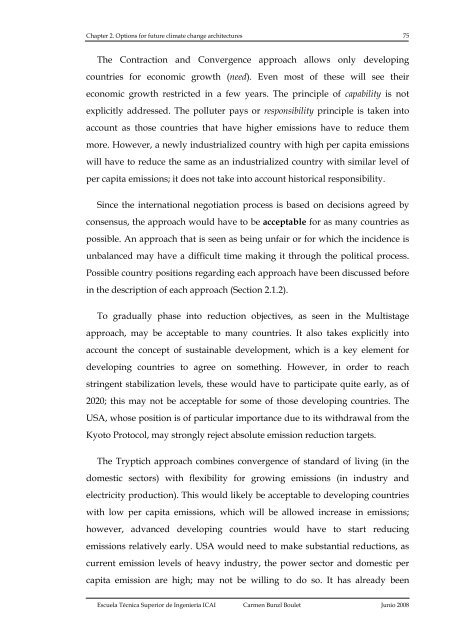Carmen Bunzl - Universidad Pontificia Comillas
Carmen Bunzl - Universidad Pontificia Comillas
Carmen Bunzl - Universidad Pontificia Comillas
You also want an ePaper? Increase the reach of your titles
YUMPU automatically turns print PDFs into web optimized ePapers that Google loves.
Chapter 2. Options for future climate change architectures 75<br />
The Contraction and Convergence approach allows only developing<br />
countries for economic growth (need). Even most of these will see their<br />
economic growth restricted in a few years. The principle of capability is not<br />
explicitly addressed. The polluter pays or responsibility principle is taken into<br />
account as those countries that have higher emissions have to reduce them<br />
more. However, a newly industrialized country with high per capita emissions<br />
will have to reduce the same as an industrialized country with similar level of<br />
per capita emissions; it does not take into account historical responsibility.<br />
Since the international negotiation process is based on decisions agreed by<br />
consensus, the approach would have to be acceptable for as many countries as<br />
possible. An approach that is seen as being unfair or for which the incidence is<br />
unbalanced may have a difficult time making it through the political process.<br />
Possible country positions regarding each approach have been discussed before<br />
in the description of each approach (Section 2.1.2).<br />
To gradually phase into reduction objectives, as seen in the Multistage<br />
approach, may be acceptable to many countries. It also takes explicitly into<br />
account the concept of sustainable development, which is a key element for<br />
developing countries to agree on something. However, in order to reach<br />
stringent stabilization levels, these would have to participate quite early, as of<br />
2020; this may not be acceptable for some of those developing countries. The<br />
USA, whose position is of particular importance due to its withdrawal from the<br />
Kyoto Protocol, may strongly reject absolute emission reduction targets.<br />
The Tryptich approach combines convergence of standard of living (in the<br />
domestic sectors) with flexibility for growing emissions (in industry and<br />
electricity production). This would likely be acceptable to developing countries<br />
with low per capita emissions, which will be allowed increase in emissions;<br />
however, advanced developing countries would have to start reducing<br />
emissions relatively early. USA would need to make substantial reductions, as<br />
current emission levels of heavy industry, the power sector and domestic per<br />
capita emission are high; may not be willing to do so. It has already been<br />
Escuela Técnica Superior de Ingeniería ICAI <strong>Carmen</strong> <strong>Bunzl</strong> Boulet Junio 2008

















